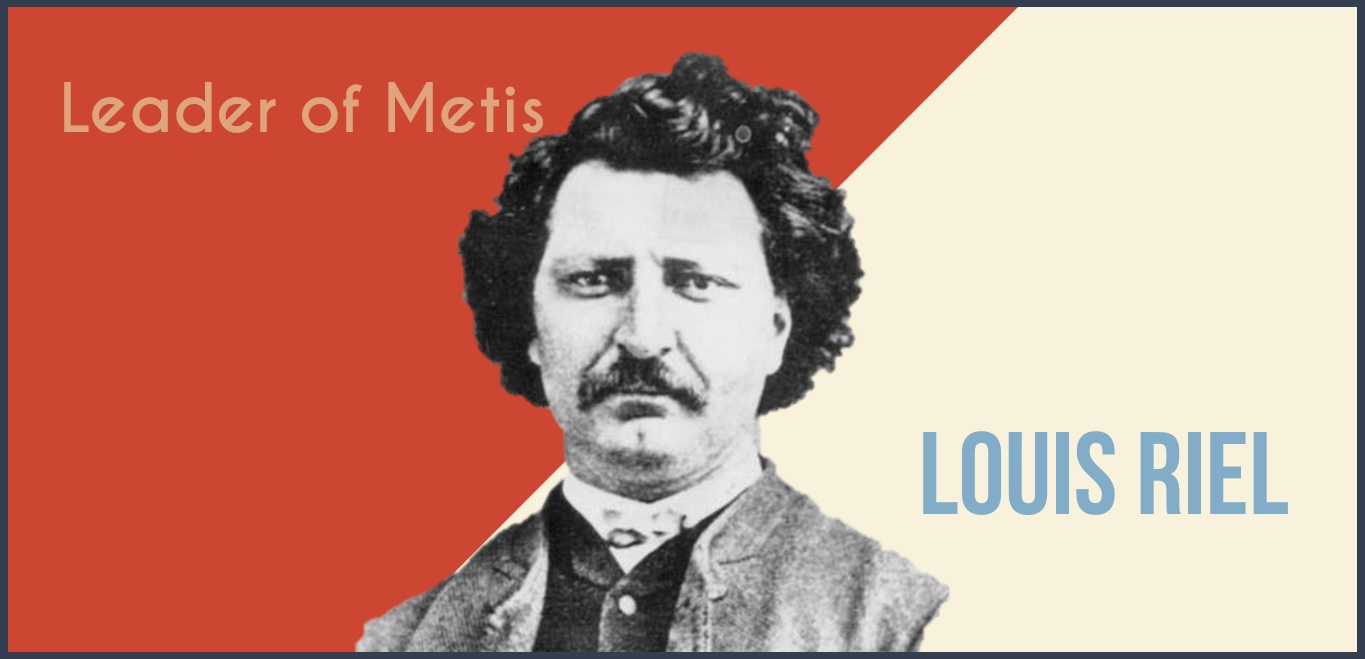Vocabulary
Before reading, translate these words.
Indigenous
Ancestry
First Nations
Francophone
Anglophone
Arrangement
Commission (verb)
Survey (geographical)
Anxiety
Negotiate
Captured
Trading post
Overthrow
Execute
Firing Squad
Warrant
Dying out
Land claim
Historical figure
Biography
The Metis
The Metis are a group of indigenous people in Canada. They have traditionally occupied the prairie provinces: Manitoba, Saskatchewan, Alberta as well as parts of Ontario, British Columbia, and Northern USA. They are a mix of indigenous and white (usually French) ancestry. The name, Metis, is actually French for “of mixed race.”
Early Life
The most famous Metis, and cultural hero, is Louis Riel. He was born in Saint Boniface (now Winnipeg), Manitoba on October 22nd, 1844. There were eleven children in his family and he was the oldest. His family was catholic, and he received his education from catholic schools. He moved to East Canada for school and work, but was unsatisfied. He returned home in 1868.
His hometown was in Red River Settlement. At that time, Canada was not yet a country and the Red River settlement was located in Reupert’s Land, a territory that would eventually become part of Canada. Rupert’s Land was actually owned by a private company, Hudson’s Bay. The people in Red River were mostly Metis and First Nations people. At this that time, the Hudson Bay company was in the process of transferring Rupert’s Land to Canada, but the political arrangements had not been made. There were many fights and disagreements with the Anglophone settlers in the area.
Red River Rebellion
In 1869, the Canadian Minister of Public Works commissioned a survey of the area. This increase anxiety among the Metis. On October 11th of that year, Riel made a speech against the survey. A group of Metis formed to represent the Metis. It was called the National Committee of the Metis and Riel became the secretary. Riel said that any attempt by Canada to control the Red River settlement must first be negotiated with the Metis.
On November 2nd, the Canadian survey team was refused entry into Red River. On the same day, a group of Metis led by Louis Riel captured For Gary, a Hudson Bay trading post. Riel’s group also captured and imprisoned some Anglophones.
The Canadian government sent representatives to Red River. Before they arrived, the National Committee of the Metis formed a government with Riel as the president. There were meetings between Riel, but they did not go well. However, he agreed to sent representatives to Ottawa to keep an open communication with the Metis.
There were Anglophones who hated the Metis. They tried to overthrow the Metis government. Riel was patient, but a man named Thomas Scott caused a lot of problems. Eventually, Riel ordered that Scott be executed by firing squad. This created even more issues with the Metis and Anglophone communities.
Riel’s group managed to negotiate with the Canadian government. Together, they established the Manitoba Act to create the province of Manitoba. However, Riel also learned that the Canadian government was trying to kill him.
Life on the Run
To avoid death, Riel moved to the Dakota Territory in the United States. It was 1870 now and the first Manitoba government was created. Many of the politicians that were elected, were Riel’s men. Riel spent most of the 1870s in hiding while also being elected to represent Red River in the Canadian government. Of course, he never went to the House of Commons for fear of death. There were many warrants out for his arrest and other people wanted him dead.
Riel also suffered a lot of mental illness at this time. He moved to the Montana Territory and became a trader and interpreter in the area. He also worked to reduce the whisky trade because it was ruining the Metis community. He became involved with Montana politics and eventually became a citizen of the United States.
Riel Returns
In the 1870s the Metis were forced to move west into the Saskatchewan Valley. However, the buffalo that they survived on were dying out. The Canadian government also failed to keep their promises. It was clear that the Metis would have to give up their way of life and become farmers. There were also many fights with the Anglophone settlers. The Metis asked Riel to return in 1884.
Riel acted like a president but from his home in Montana. He helped to settle arguments and land claims. At first, he received a lot of support, but that disappeared over time. He brought his religion into politics. He talked a lot about the Catholic church and started to believe that God appointed him to be the leader.
In early 1885, Riel was leading an open rebellion against the Canadian government. However, the Canadian Pacific Railway allowed Canada to send the military quickly and they captured Riel. At his trial, his lawyers argued that he was not guilty by reason of insanity, the jury found him guilty, but recommended mercy, but the judge sentenced him to death. Canada’s first Prime Minister, John A. MacDonald was responsible for forcing the death penalty. Louis Riel was hanged on November 16th, 1885 for treason.
Legacy
Louis Riel is a debated historical figure. He is seen as a hero by the Metis. Francophones saw his death as a symbol of Anglophone dominance. Eventually, Quebecers would seem him as the perfect hero. Some people see Louis Riel as an insane traitor. Some people think he did what needed to be done to protect the Metis people. Either way, Riel was an important historical figure in Canada. Louis Riel Day is celebrated in Manitoba on February 18th each year.
Questions
The questions will guide you through the reading and give a deeper understanding of the text
- Who are the Metis?
- Where was Louis Riel born?
- Who owned Red River Settlement?
- The first “Riel Rebellion” happened in 1869. What happened?
- Which province did Riel help create?
- Why did he hide in Dakota Territory?
- The second “Riel Rebellion” happened in 1885. What happened?
- What was the result of his trial?
- Who was the Prime Minister that responsible for Riel’s death penalty?
- How is Louis Riel remembered today?
- How do you feel about Louis Riel? Is he a hero, a traitor, or an insane man?
- Is capital punishment ok?
- What should be the penalty for treason?


